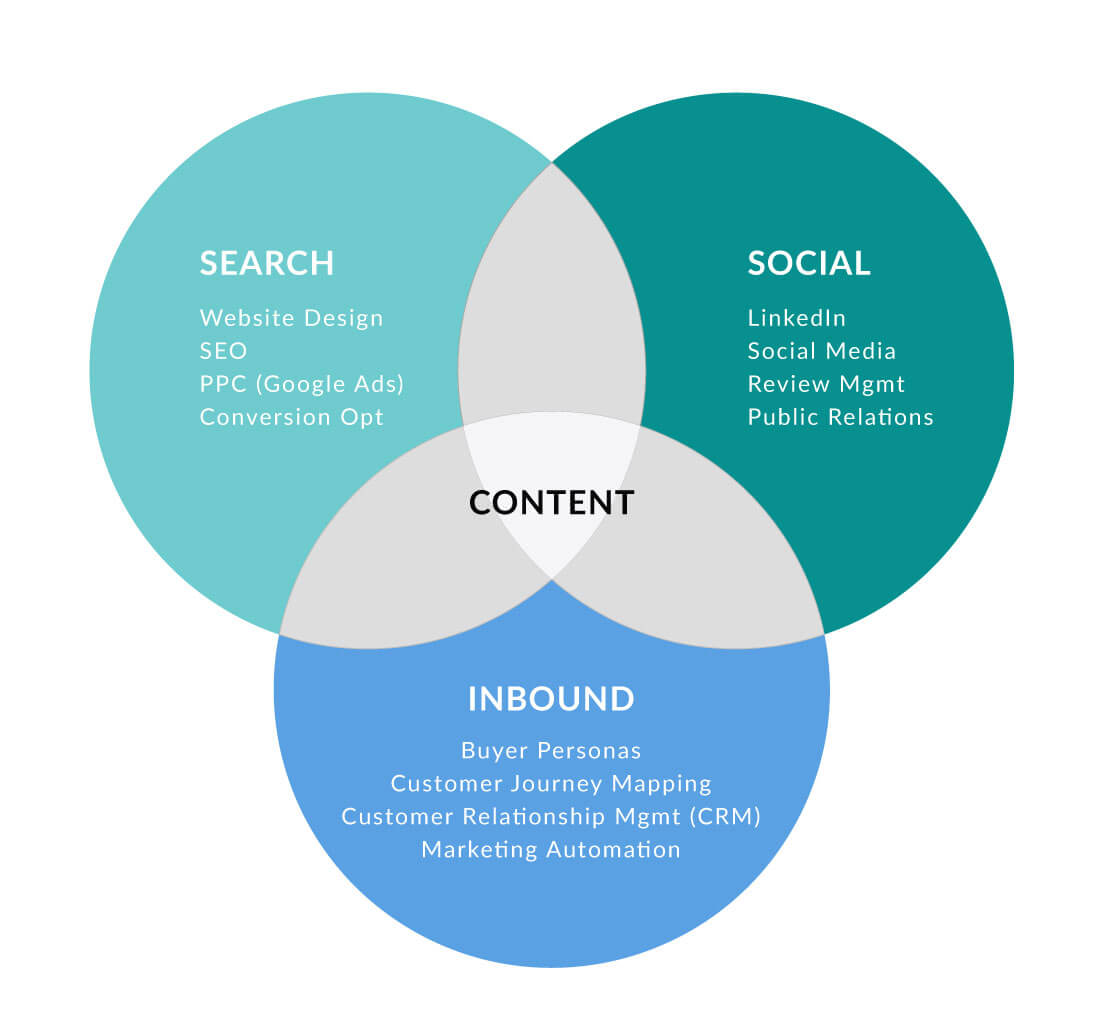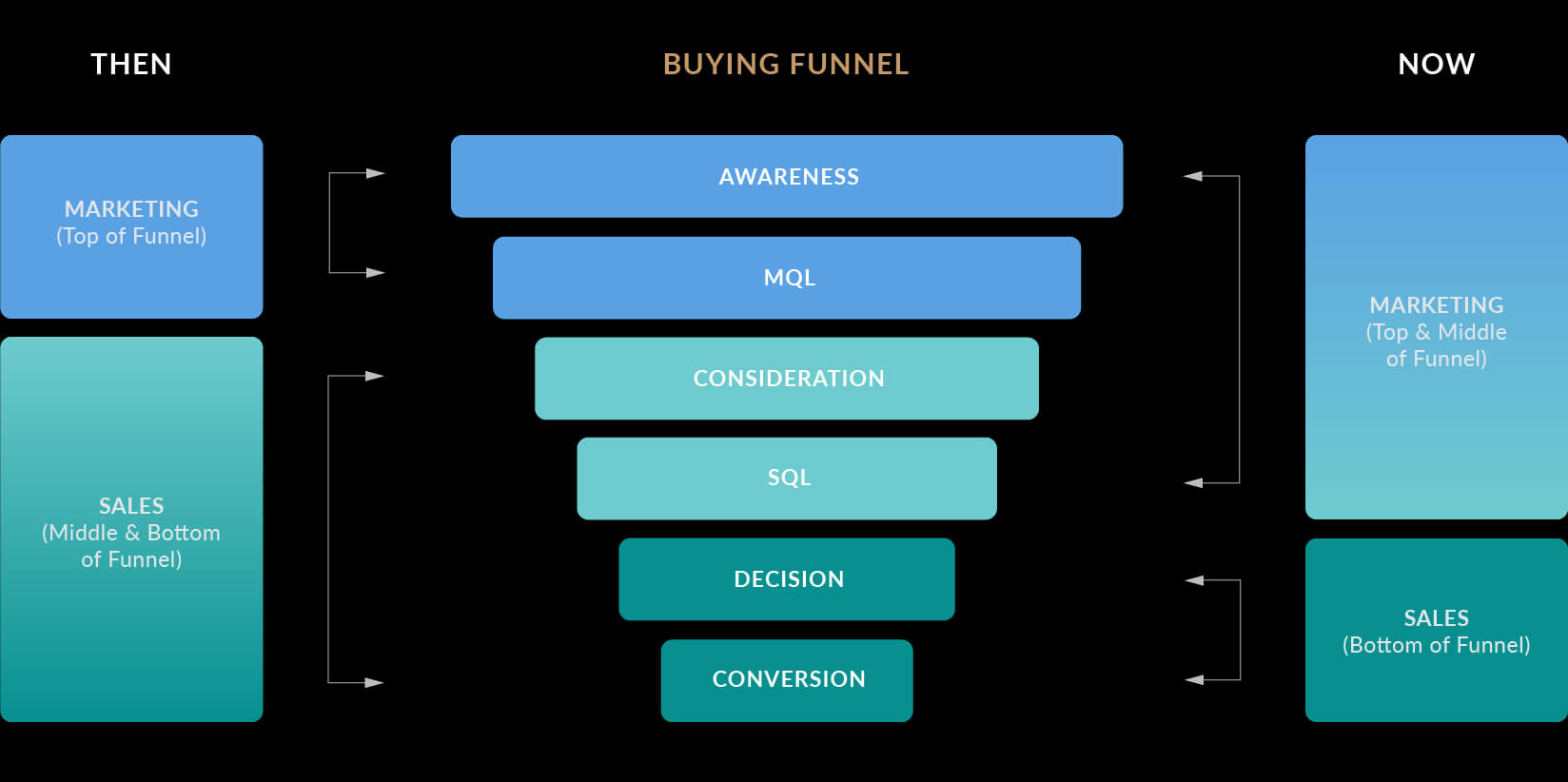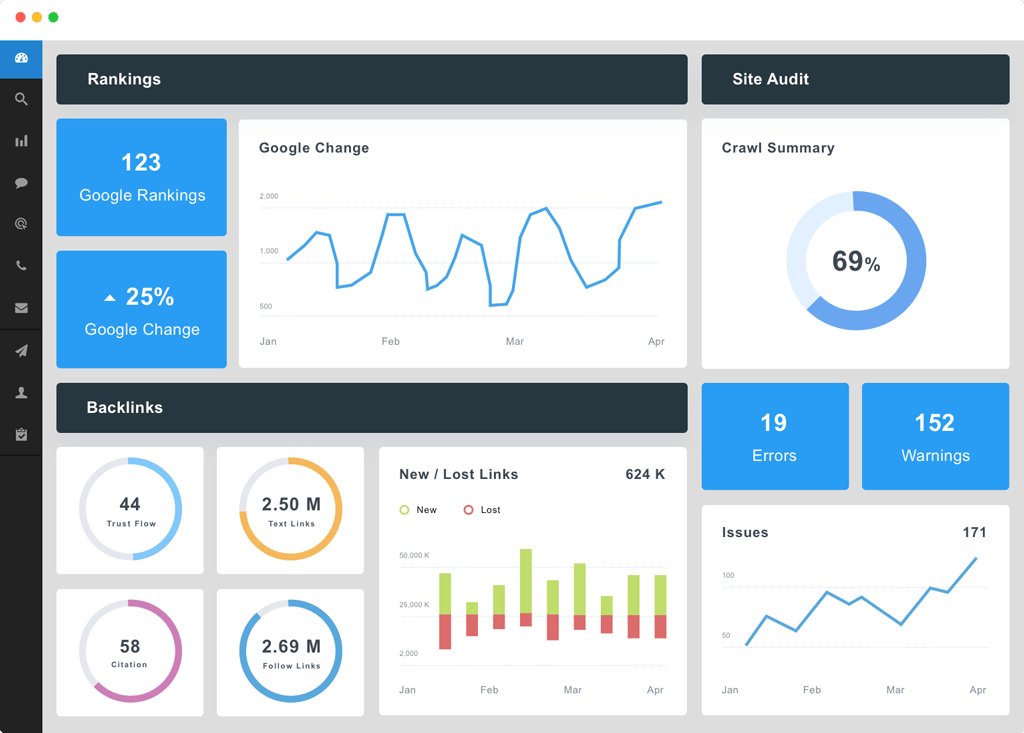Digital's Impact on
Today's B2B Companies
MARKETING & SALES ROLES ARE FUNDAMENTALLY CHANGING
Traditionally, the sales approach involved cold calls, trade shows, purchased contact lists, and other activities—many of which would be deemed spam-worthy by today’s standards. The marketing department produced brochures, one-sheets, and other marketing collateral to support sales efforts. When a buyer needed a product or solution, they would contact a vendor, get a brochure, engage a salesperson, listen to their pitch, and if they liked what they heard, make a purchase. The process was straightforward and predictable.
But today’s buyers have access to all the seller information they need (via Google search), and the B2B buying process has become a complex, non-linear journey—with the elimination of sellers occurring well before the salesperson is involved. In fact, according to a recent survey, only 12% of B2B buyers even want to meet with a sales representative. As a result, marketing, rather than sales, is responsible for feeding and nurturing the sales funnel, and the salesperson is reduced to assisting buyers in the final stages of the purchase journey.
Digital's Impact
on Today's B2B Companies
MARKETING & SALES ROLES ARE FUNDAMENTALLY CHANGING
Traditionally, the sales approach involved cold calls, trade shows, purchased contact lists, and other activities—many of which would be deemed spam-worthy by today’s standards. The marketing department produced brochures, one-sheets, and other marketing collateral to support sales efforts. When a buyer needed a product or solution, they would contact a vendor, get a brochure, engage a salesperson, listen to their pitch, and if they liked what they heard, make a purchase. The process was straightforward and predictable.
But today’s buyers have access to all the seller information they need (via Google search), and the B2B buying process has become a complex, non-linear journey—with the elimination of sellers occurring well before the salesperson is involved. In fact, according to a recent survey, only 12% of B2B buyers even want to meet with a sales representative. As a result, marketing, rather than sales, is responsible for feeding and nurturing the sales funnel, and the salesperson is reduced to assisting buyers in the final stages of the purchase journey.
Marketing's Role: Then & Now
Direct interaction between the buyer and seller has been steadily decreasing. Consequently, marketing has become an organization’s primary demand generation engine and needs to cover a much wider part of the sales funnel. In this new B2B era, sales and marketing teams must work together. The diagram below reflects the difference between sales and marketing roles in the old and new buyer’s journey.
Consider these statistics about how today’s B2B buyers interact with suppliers and vendors:
Only 17% of the B2B buying process is spent meeting with vendors
Almost 90% of the buyers journey is complete before engaging a vendor
62% of B2B buyers say they can make a purchase selection based solely on digital content
Marketing's Role: Then & Now
Direct interaction between the buyer and seller has been steadily decreasing. Consequently, marketing has become an organization’s primary demand generation engine and needs to cover a much wider part of the sales funnel. In this new B2B era, sales and marketing teams must work together. The diagram below reflects the difference between sales and marketing roles in the old and new buyer’s journey.
Consider these statistics about how today’s B2B buyers interact with suppliers and vendors:
Only 17% of the B2B buying process is spent meeting with vendors
Almost 90% of the buyers journey is complete before engaging a vendor
62% of B2B buyers say they can make a purchase selection based solely on digital content
SHIFTING TO DIGITAL INTERACTIONS
The B2B Sales & Marketing
Inflection Point
In the past decade, the adoption of digital technologies moved forward at a steady pace. But in just a few months, COVID-19 brought years of change in the way companies do business. According to a recent study, the pandemic sped up digital transformation by 5.3 years, and it is estimated that spending on digital transformation will nearly double between 2020 and 2023. The prevailing wisdom used to be that e-commerce was only for small-ticket items. Not so anymore. Now, more than 75% of buyers and sellers state they prefer digital, self-guided service and remote interactions over in-person engagements. As buyers shift more activities online, businesses will need to accelerate marketing and sales transformation plans to stay relevant and competitive.

SHIFTING TO DIGITAL INTERACTIONS
The B2B Sales & Marketing Inflection Point

In the past decade, the adoption of digital technologies moved forward at a steady pace. But in just a few months, COVID-19 brought years of change in the way companies do business. According to a recent study, the pandemic sped up digital transformation by 5.3 years, and it is estimated that spending on digital transformation will nearly double between 2020 and 2023. The prevailing wisdom used to be that e-commerce was only for small-ticket items. Not so anymore. Now, more than 75% of buyers and sellers state they prefer digital, self-guided service and remote interactions over in-person engagements. As buyers shift more activities online, businesses will need to accelerate marketing and sales transformation plans to stay relevant and competitive.
Understanding The Buyer's Journey
The Buyer’s Journey is the process consumers go through to become aware of, evaluate, and purchase a product or service. These three stages make up the inbound marketing framework: awareness, consideration, and decision. Dymic analyzes the Buyer’s Journey through this lens to conceptualize the buyer’s path and create relevant, buyer-persona-targeted content for each stage in the buying process.
Understanding The Buyer's Journey
The Buyer’s Journey is the process consumers go through to become aware of, evaluate, and purchase a product or service. These three stages make up the inbound marketing framework: awareness, consideration, and decision. Dymic analyzes the Buyer’s Journey through this lens to conceptualize the buyer’s path and create relevant, buyer-persona-targeted content for each stage in the buying process.
PUSH VS. PULL
New B2B
Marketing Mindset
Today, B2B buyers do most of their research online, and they value suppliers who make it easier for them to navigate the purchase process. When there is an interaction with sales, it is much more consultative—with sellers providing helpful information about products and services via case studies, white-papers, and other forms of buyer-driven content. Instead of always-be-closing (push-logic), the new approach is always-be-helping (pull-logic). This makes content offerings for each stage of the journey essential to helping the buyer through their decision-making process. Moreover, it means content marketing is critical to B2B sales and marketing success.
76% of marketers use organic traffic as a measure of content success
Over half of all content created in 2019 was for the top of the sales funnel
PUSH VS. PULL
New B2B
Marketing Mindset
Today, B2B buyers do most of their research online, and they value suppliers who make it easier for them to navigate the purchase process. When there is an interaction with sales, it is much more consultative—with sellers providing helpful information about products and services via case studies, white-papers, and other forms of buyer-driven content. Instead of always-be-closing (push-logic), the new approach is always-be-helping (pull-logic). This makes content offerings for each stage of the journey essential to helping the buyer through their decision-making process. Moreover, it means content marketing is critical to B2B sales and marketing success.
76% of marketers use organic traffic as a measure of content success
Over half of all content created in 2019
was for the top of the sales funnel
IDEAS, INSIGHTS & THOUGHT-LEADERSHIP
Content: New B2B Marketing Fuel
The emergence of digital raised the level of expertise required for marketing success and now there are hundreds of skills and disciplines in the B2B marketing toolkit. But in a world where buyers are inundated with advertisements, nothing matters more than hyper-relevant, buyer-focused content because people care about their problems more than they care about products or services. Since marketing now owns most of the sales pipeline, content has become the sales consultant, sales pitch, and subject matter expert. The importance of ideas, insights, and thought-leadership—expressed through content—has never been clearer. Here are some of the content creation benefits, along with a link to download our B2B Content Marketing Strategy Checklist.
IDEAS, INSIGHTS
& THOUGHT-LEADERSHIP
Content: New B2B Marketing Fuel
The emergence of digital raised the level of expertise required for marketing success and now there are hundreds of skills and disciplines in the B2B marketing toolkit. But in a world where buyers are inundated with advertisements, nothing matters more than hyper-relevant, buyer-focused content because people care about their problems more than they care about products or services.
Since marketing now owns most of the sales pipeline, content has become the sales consultant, sales pitch, and subject matter expert. The importance of ideas, insights, and thought-leadership—expressed through content—has never been clearer. Here are some of the content creation benefits, along with a link to download our B2B Content Marketing Strategy Checklist.
New B2B
Marketing Engine
THE MOST IMPORTANT B2B MARKETING PILLARS
The key to understanding how search, social, and inbound work together is in the problem they solve: buyer information discovery. When brands capture their expertise, package it, and distribute it through these channels using the inbound framework, it helps buyers do their jobs and make smarter decisions. Moreover, it earns attention, creates value, establishes trust, and develops a more valuable brand-buyer relationship. These three pillars are critical to earning more traffic, driving more conversions, and building a formidable content brand, and it’s how successful B2B brands are winning the battle for their buyer’s attention.

New B2B
Marketing Engine
THE MOST IMPORTANT B2B MARKETING PILLARS
The key to understanding how search, social, and inbound work together is in the problem they solve: buyer information discovery. When brands capture their expertise, package it, and distribute it through these channels using the inbound framework, it helps buyers do their jobs and make smarter decisions. Moreover, it earns attention, creates value, establishes trust, and develops a more valuable brand-buyer relationship. These three pillars are critical to earning more traffic, driving more conversions, and building a formidable content brand, and it’s how successful B2B brands are winning the battle for their buyer’s attention.
Search
Pillar #1
Increase Traffic
& Bridge the Divide
Understanding what people are searching for, the answers they seek, the words they use, and the type of content they need is essential to B2B marketing success. The answers to these questions enable brands to connect buyers with the solutions they offer. High quality content is what earns backlinks, and it's what search engines crawl on a website. Creating content that aligns with the audience’s intent is one side of the SEO coin. Delivering it in a way that buyers and search engine’s can find and understand it – is the other side.
48 percent of people cited web design is the #1 factor in determining the credibility of a business.
67% of marketers say SEO is the most effective marketing tactic
Social
Pillar #2
Solve the B2B
Social Media Problem
Social media is especially challenging for B2B brands, and they typically fall prey to the following pitfalls: posting without purpose, creating content that falls flat, and building campaigns that come across too salesy. But Social Media offers a way to differentiate, demonstrate authenticity, and build trust. Moreover, it provides an opportunity to make life better for the audience. Whether it's helping them buy with confidence, making them wiser about the industry or giving them insight into the brand and its products or services. And when companies make it easy for buyers to make smart purchases, they voice their positive experiences, leave positive reviews, provide endorsements, and refer their friends, families and business associates.
46% of all social media traffic to company websites come from LinkedIn
85% of consumers trust online reviews as much as personal recommendations.
Inbound
Pillar #3
Adopt & Embrace
the Inbound Methodology
The Inbound Marketing Methodology integrates content marketing with a range of other digital marketing tactics, like SEO, PPC and email, to maximize the generation of traffic, leads and revenue. Most importantly, it aligns digital marketing efforts with the buyer’s needs, pain-points, and decision making process at a time when they are most interested in finding a solution. When marketers understand the way their buyers make decisions, it’s much easier to see which tactics play a role in each stage of the journey. Not only does the Inbound Strategy produce more qualified, sales ready leads, but it does so for a fraction of the traditional outbound sales and marketing costs.
60% of marketers say that inbound is their highest quality source of leads
On average, every $1 spent on email marketing results in $44 in ROI
Search
Pillar #1
Increase Traffic & Bridge the Divide
Understanding what people are searching for, the answers they seek, the words they use, and the type of content they need is essential to B2B marketing success. The answers to these questions enable brands to connect buyers with the solutions they offer. High quality content is what earns backlinks, and it's what search engines crawl on a website. Creating content that aligns with the audience’s intent is one side of the SEO coin. Delivering it in a way that buyers and search engine’s can find and understand it – is the other side.
48 percent of people cited web design is the #1 factor in determining the credibility of a business.
67% of marketers say SEO is the most effective marketing tactic
Social
Pillar #2
Solve the B2B Social Media Problem
Social media is especially challenging for B2B brands, and they typically fall prey to the following pitfalls: posting without purpose, creating content that falls flat, and building campaigns that come across too salesy. But Social Media offers a way to differentiate, demonstrate authenticity, and build trust. Moreover, it provides an opportunity to make life better for the audience. Whether it's helping them buy with confidence, making them wiser about the industry or giving them insight into the brand and its products or services. And when companies make it easy for buyers to make smart purchases, they voice their positive experiences, leave positive reviews, provide endorsements, and refer their friends, families and business associates.
46% of all social media traffic to company websites come from LinkedIn
85% of consumers trust online reviews as much as personal recommendations.
Inbound
Pillar #3
Adopt & Embrace the Inbound Methodology
The Inbound Marketing Methodology integrates content marketing with a range of other digital marketing tactics, like SEO, PPC and email, to maximize the generation of traffic, leads and revenue. Most importantly, it aligns digital marketing efforts with the buyer’s needs, pain-points, and decision making process at a time when they are most interested in finding a solution. When marketers understand the way their buyers make decisions, it’s much easier to see which tactics play a role in each stage of the journey. Not only does the Inbound Strategy produce more qualified, sales ready leads, but it does so for a fraction of the traditional outbound sales and marketing costs.
60% of marketers say that inbound is their highest quality source of leads
On average, every $1 spent on email marketing results in $44 in ROI
THE DYMIC DASHBOARD
Tracking B2B Marketing Performance
Dymic’s Analytics Dashboard provides clients with comprehensive campaign reporting to track and measure incremental gains and key metrics in the three pillars (search, social, and inbound) of their B2B marketing strategy. This reporting tool integrates with Google Analytics and social platforms to show Dymic clients exactly how their marketing campaigns impact their bottom-line. And the dashboard can be used on any device so clients can see the value of their marketing investment anytime, anywhere.
THE DYMIC DASHBOARD
Tracking B2B Marketing Performance
Dymic’s Analytics Dashboard provides clients with comprehensive campaign reporting to track and measure incremental gains and key metrics in the three pillars (search, social, and inbound) of their B2B marketing strategy. This reporting tool integrates with Google Analytics and social platforms to show Dymic clients exactly how their marketing campaigns impact their bottom-line. And the dashboard can be used on any device so clients can see the value of their marketing investment anytime, anywhere.



